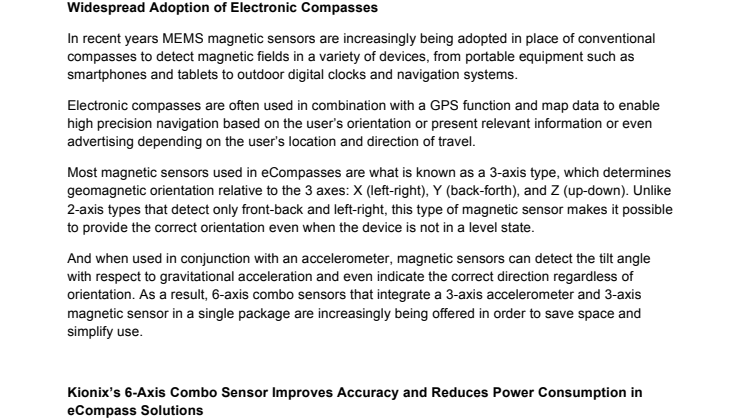Blog post -
Kionix High Accuracy eCompass Solution
Widespread Adoption of Electronic Compasses
In recent years MEMS magnetic sensors are increasingly being adopted in place of conventional compasses to detect magnetic fields in a variety of devices, from portable equipment such as smartphones and tablets to outdoor digital clocks and navigation systems.
Electronic compasses are often used in combination with a GPS function and map data to enable high precision navigation based on the user’s orientation or present relevant information or even advertising depending on the user’s location and direction of travel.
Most magnetic sensors used in eCompasses are what is known as a 3-axis type, which determines geomagnetic orientation relative to the 3 axes: X (left-right), Y (back-forth), and Z (up-down). Unlike 2-axis types that detect only front-back and left-right, this type of magnetic sensor makes it possible to provide the correct orientation even when the device is not in a level state.
And when used in conjunction with an accelerometer, magnetic sensors can detect the tilt angle with respect to gravitational acceleration and even indicate the correct direction regardless of orientation. As a result, 6-axis combo sensors that integrate a 3-axis accelerometer and 3-axis magnetic sensor in a single package are increasingly being offered in order to save space and simplify use.
Kionix’s 6-Axis Combo Sensor Improves Accuracy and Reduces Power Consumption in eCompass Solutions
Amid increased market expectations for eCompasses, ROHM Group Company Kionix, a leading supplier of MEMS sensors based in Ithaca, New York, has developed the KMX61, an ultra-compact, ultra-low-power 6-axis combo sensor that combines a 3-axis magnetometer and 3-axis accelerometer in a single package.

KMX61 6-Axis Sensor for Electronic Compasses
MI Technology Provides Greater Precision While Minimizing Power Consumption in MEMS Magnetic Sensors
The KMX61, which in addition to the 3-axis magnetic sensor and 3-axis accelerometer MEMS incorporates a control ASIC in a compact (3x3x0.9mm) 16pin single LGA package, is ideal for 6-axis electronic compasses.
3 rd generation MI (Magnetic Impedance) technology is utilized to provide superior magnetic sensing sensitivity (0.05uT/count) compared with conventional Hall and MR sensors by energizing pulse current within a special nanotechnology-based electron spin array amorphous wire to detect ultra-small magnetic fields.

Magnetic Sensor Technologies
MI sensors feature 10,000 times greater sensitivity than conventional Hall sensors, and the horizontal magnetic field component tends to be small even at high latitudes, enabling high accuracy orientation detection within an azimuth error of 1°.
Magnetic impedance also provides additional benefits, including 1/6 th the current consumption and 28 times faster measurement speed, making it ideal for demanding applications with power constraints, such as portable devices and wearable tech.
KMX61: Key Features
KMX61 combines an MI-type magnetic sensor MEMS, a market-proven high-performance accelerometer MEMS, and a multifunction ASIC, and features a power supply range of 1.8-3.3V and an operating temperature range of between 40 and +85°C.
The internal magnetic sensor delivers a measurement range of ±1200µT, while the accelerometer supports ±2g/±4g/±8g detection (user selectable). The ASIC utilizes standard 0.18µm CMOS technology and provides 14bit digital output via I 2C. In addition, a 512 Byte FIFO buffer with watermarking function is built in, and internal caching of system data reduces host MCU access frequency, minimizing system power consumption. Additional features include an internal temperature sensor for calibration, status detection interrupt such as wakeup, and self-test capability.
KMX61 also supports automatic calibration software utilizing proprietary algorithms by detecting the ambient magnetic field in order to ensure stability against temperature (±0.05%/degree). And to enable seamless embedding in different user environments, compatibility with Windows 8 and Android operating systems is provided, along with transplant support for MCU environments with no OS installed. This makes the KMX61 the ideal eCompass solution for a wide variety of compact battery-driven portable equipment and wearable tech devices.
Future Developments
ROHM, together with Group Companies LAPIS Semiconductor and Kionix, offers a range of field sensing devices that provide fast, accurate monitoring and detection of ambient conditions, including proximity, brightness, and UV radiation, along with motion sensing solutions that can accurately determine position and behavior such as acceleration, magnetic fields, and pressure. A wide range of peripheral devices are also available, including wireless communication modules and power supply components required for configuring sensor networks and dedicated microcontrollers designed to control multiple sensors. Going forward, the ROHM Group will continue to develop complex devices as well as next-generation solutions that take advantage of technological synergy by leveraging ROHM’s analog expertise and LAPIS Semiconductor’s market-leading low-power microcontroller lineup with Kionix’s MEMS technology.
Related links
Topics
- Energy
Categories
- rohm semiconductor
- kionix
- mems
- ecompass
- mi sensor
- magnetic impedance
- sensor
- rohm
- accelerometer


